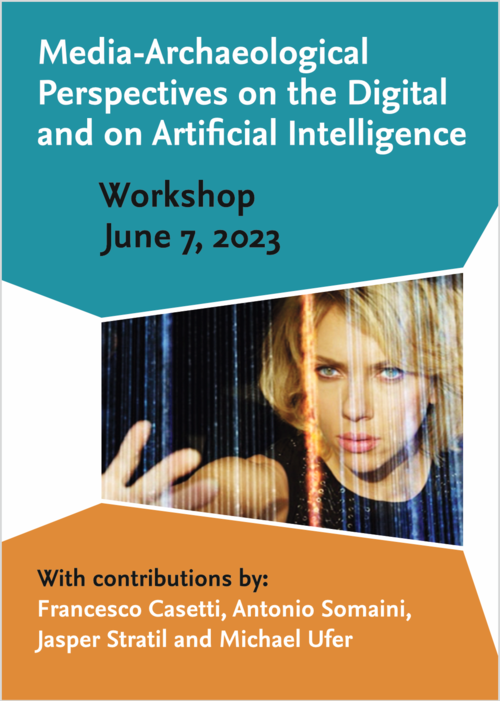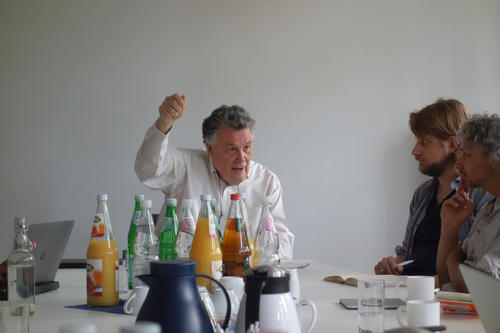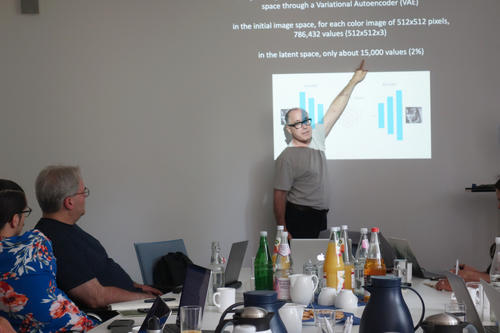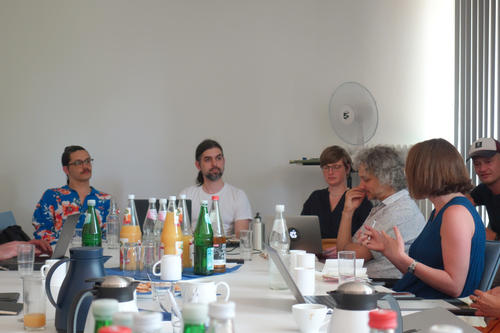Media-Archaeological Perspectives on the Digital and on Artificial Intelligence
07.06.2023 | Workshop by the Cinepoetics group with Francesco Casetti, Antonio Somaini, Jasper Stratil, and Michael Ufer.
Research Focus: Audiovisual Cultures III: Digital Cultures of the Moving Image
With digital image technologies evolving at a quick pace, our workshop ventured into the question of what is left behind. Is there a surplus of a media archaeology of the digital? What methods are available for this and to what extent do we have to ask new questions that may overcome a binary logic of old and new?
In the first presentation of the workshop, “A Rhizomatic Archaeology of Digital Images,” Francesco Casetti hinted at a media archaeological mode that circumvents this binary logic: following flows and regulations of the digital. He employed a Foucauldian method by underlining the excavational aspects of such an archaeology of digital media. Rather than finding and preserving objects, one has to concentrate on a thickening of areas in the episteme to understand the processual nature of knowledge transfer. Media archaeological excavation may be understood as a rhizomatic approach, Casetti explained.
Following this, he deducted two hypotheses that grant media archaeological research without falling into the pitfalls of presentism. First, media must be understood as assemblages, that is provisional coherences that are always in motion. And second, the emergence of media is an event that not only obeys to internal logics. From this viewpoint, one may be able to understand the history of media as an exchange between technique and technology, as Casetti concluded with a theoretical nod to John Durham Peters (as well as Walter Benjamin).
After the lunch break, Antonio Somaini shared his perspective on “The Visible and the Sayable. The Impact of Artificial Intelligence on Images and Visual Culture.” He set out to define three different phases of the discourse on “artificial intelligence” (as this terminology is popular but not very precise, Somaini uses inverted commas): machine vision (around 2010), generative adversarial networks (GANs, in the mid-2010s) and the widespread diffusion of text-to-image and image-to-text models in 2022. Following Somaini, we must ask what kind of images these models produce and what operations they are capable of.
He went on to demonstrate these operations with Grégory Chatonsky’s “The Hundred Headless Machine” (2022), a reflection on Max Ernst’s surreal “image novels” from the 1920s. Both of these works convey the processual qualities of text-image combinations that, as Somaini puts it, unfold automatically. However, one must carefully analyze the sources and datasets that underlie image generators such as DALL-E 2, which Chatonsky used for his project. Processes of en-/decoding as well as training these models with trillions of images are highly political and important for any media archaeological approach.
A third presentation, by Jasper Stratil and Michael Ufer, together with a final discussion concluded the workshop. “Pygmalionic Poetics of Digitality – The Curious Case of Scarlett Johansson’s AI Cycle” focused on four films in which the actress plays different forms of artificial intelligence, namely HER (2013), UNDER THE SKIN (2013), LUCY (2014), and GHOST IN THE SHELL (2017). By way of Stanley Cavell’s notion of type, figuration, and medium, Stratil and Ufer approached the enigma of conjunction – a fact of any audiovisual culture – underlining that every film can only be understood in view of others.
Their presentation took AI not as a starting point for the analysis, but as something that can only be understood through its mediation. Stratil and Ufer linked this to Cavell’s concept of photogenesis, the act of becoming through audiovisual images. Thus, AI and the type ‘Scarlett Johansson’ are in itself reflections on audiovisual culture “under the sense of the digital,” as Stratil and Ufer put it.
The event concluded with a final discussion that revolved around the topics of all three presentations. Especially questions of corporeality, gender, and the political implications of artificial intelligence/large-language-models were discussed.





